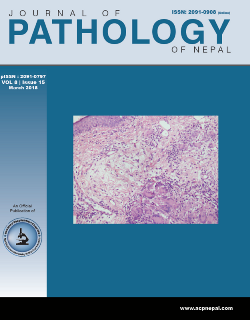Aspiration and non-aspiration technique in the study of thyroid gland lesion cytology
DOI:
https://doi.org/10.3126/jpn.v8i1.19446Keywords:
Aspiration, Non-aspiration, ThyroidAbstract
Background: Fine needle aspiration cytology is used as a primary diagnostic tool in thyroid lesions. But the bloody smears caused by negative pressure during aspiration compromise cellular concentration and cell morphology which may lead to its improper interpretation. FNNAC avoids active aspiration and depends on capillary tension to collect tissue sample in the needle bore, thus reducing bleeding and tissue trauma to the highly vascular thyroid.
Material and Methods: This is a one year prospective study where FNNAC and FNAC were done on 87 patients. Cytopathologist was blind folded regarding the technique used and was asked to score the quality of slide base of Mair scoring system.
Results: FNAC yielded significantly better material on the basis of hemorrhage and cellularity. Fifty six (64.37%) cases showed adequate diagnostic material in FNNAC technique while 54/87 (62.05%) cases showed adequate diagnostic material in FNAC technique. Twelve (13.79%) cases showed unsuitable diagnostic material in FNNAC technique and 26/ 87 (29.89%) cases unsuitable diagnostic material in FNAC technique. Among the individual criteria used in Mair scoring system, background clot/ blood was significantly low in FNNAC than FNAC with the p value less than 0.001. Amount of cellular material was significantly more in FNNAC with p value less than 0.001.
Conclusion: FNNAC yielded more cellular and less hemorrhagic material and more diagnostic superior material than FNAC. Since thyroid is a highly vascular gland, FNNAC should be used instead of FNAC for less hemorrhagic and more cellular material.
Downloads
Downloads
Published
How to Cite
Issue
Section
License
This license enables reusers to distribute, remix, adapt, and build upon the material in any medium or format, so long as attribution is given to the creator. The license allows for commercial use.




